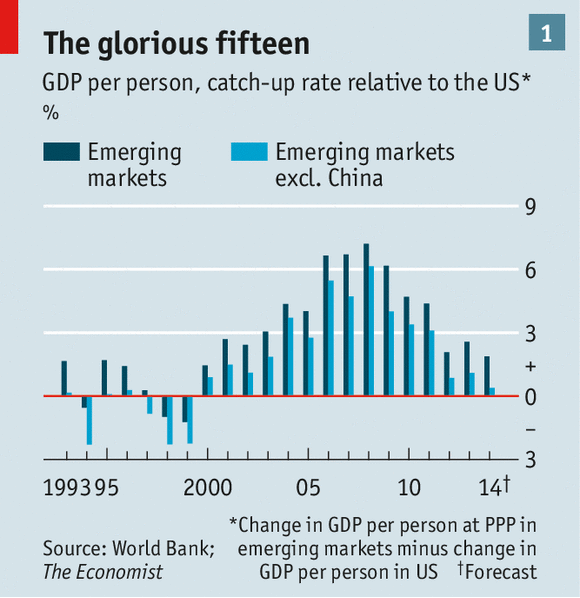I quote from the lead article in The Economist this week (from which the graph is taken):
"When adjusted for living costs, output per person in the emerging world almost doubled between 2000 and 2009; the average annual rate of growth over that decade was 7.6%, 4.5 percentage points higher than the rate seen in rich countries.......This burst of growth struck an extraordinary blow against deprivation. The share of the developing world’s population living on less than $1.25 a day (the international definition of poverty) has fallen from 30% in 2000 to below 10%, according to an estimate by the Centre for Global Development, based on new data published by the World Bank in April.......
"Since 2008 growth rates across the emerging world have slipped back toward those in advanced economies. When the new ICP estimates are applied, the average GDP per head in the emerging world, measured on a purchasing-power-parity (PPP) basis, grew just 2.6 percentage points faster than American GDP in 2013. If China is excluded from the calculations the difference is just 1.1 percentage points."Note that the graph above is not the rate of growth of GDP per person (PPP), but rather the rate at which the GDP per capita is catching up with that of the USA. The developing countries apparently started converging economically more rapidly with the United States (and other rich countries) in 2000 and the rate of convergence increased until 2008. Since 2008, the rate of convergence has decreased year after year for developing countries with the exception of China.
Even China has a much less rapid convergence than was the case in 2008. but it continues to grow relatively rapidly. Who knows what the future will bring. "Prediction is difficult, especially about the future". One prediction is safe -- far too many people in the world will continue in extreme poverty and far too many will continue almost as poor as those in extreme poverty!


No comments:
Post a Comment